MAN Wiki
Stereophonic
Stereo microphone systems 1
A-B (delay-based)
A-B microphone system uses two parallel omnidirectional? microphones with a clear distance.
Pro & Cons
The AB setup provides a pleasant reproduction of the reverberant sound field and provides useful spatial information. 2
Compared with other setups, the A-B setup usually provides less distinctive directional information. Another possible drawback may be the summed signal of a A-B setup would suffer from comb filtering? effects.
Recording angle and microphone spacing measurement
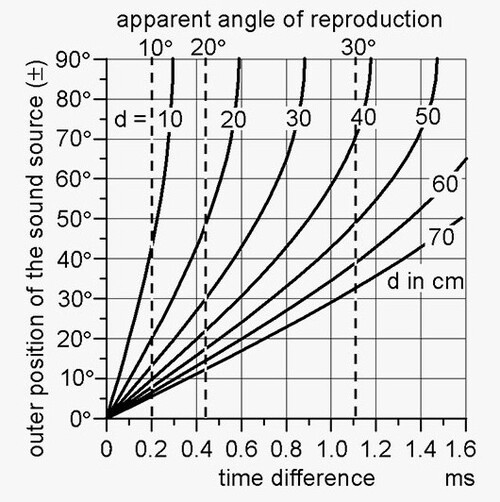
The scale on the horizontal axis indicates the time difference between the microphones in milliseconds and the scale on the vertical axis indicates the position (width) in degrees of the sound source to be recorded.
Procedure
- Select a desired distance between the sound source and the microphone setup
X-Y (intensity-based, coincident)
The term coincident here indicates that the microphone capsules must be placed close and normally slightly above each other, without any physical contact .
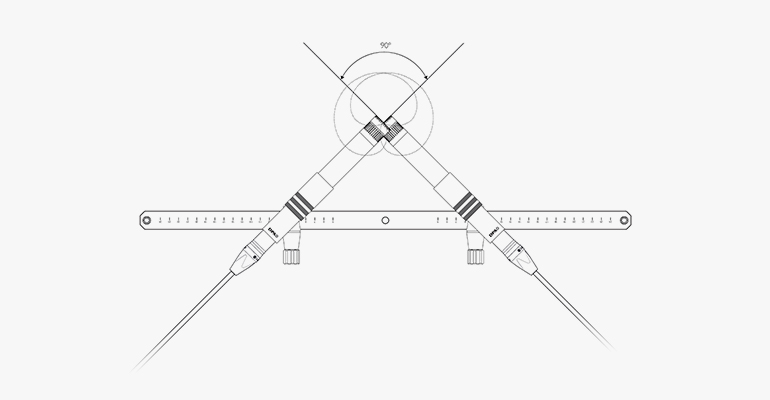
Comparing it with an A-B setup, we would not have any comb filtering? effects.
The relationship between the width of the sound source and the angle between microphones is as follows: the wider the sound source, the narrower the angle between the microphones . This principle is essential for optimizing recording quality and enhancing sound field capture.
Recording angle and sound source coverage in the X-Y setup
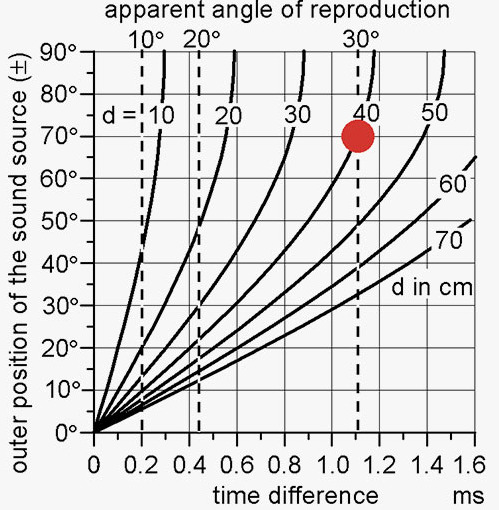
The red dot indicates a setup with an X-Y microphone pair spaced 40 cm (16 in) apart, featuring a recording angle of . The outer limits of the recording angle should be reproduced at (time difference approximately 1.1 ms).
Example: X-Y Blumlein pair (recording angle: )
Blumlein pair uses the setup of two identical crossed figure-of-eights microphones, and arranged in complete symmetry with respect to the recording axis. According to Michael Gerzon, the Blumlein pair system has a most remarkable stereo stability.
A classic Blumleinian coincident microphone pair uses two figure-of-eight microphones pointing to , in other words, two microphones are positioned from each other.
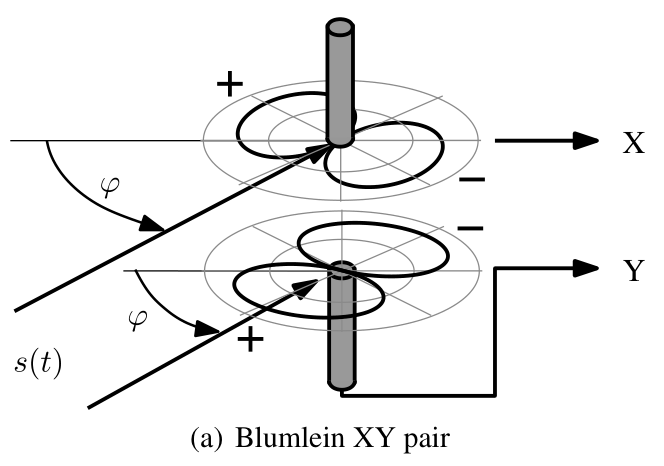
The pickup pattern of a classic Blumleinian microphone pair can be defined as:
where is the angle of the sound source relative to the microphone pair, is the response of the Blumlein microphone pair to sound signals at different angles of incidence , and represents the front-right signal, while represents the front-left one.
Assuming a signal originates from an angle of , the pickup signals’s gain can be expressed as:
As the sound source moves from the right channel at an angle of to the left channel at an angle of , the captured signal would be panned from the channel to the channel , the transition can be represented as follows:
Sound comes from the sides that have angles ranged from to and certainly also to will make a Blumleinian microphone pair producing out-of-phase signals between and channels.
Compared to a A-B microphone system, the sonic characteristic of a Blumleinian microphone pair has weaker sense of space and depth.
ORTF: (near-coincident)
ORTF (Office de Radiodiffusion Télévision Française) is a variation on the basic X-Y coincident technique, which uses two cardioid? microphones spaced 7 inches (17 cm) apart and facing outward with an angle of between them.
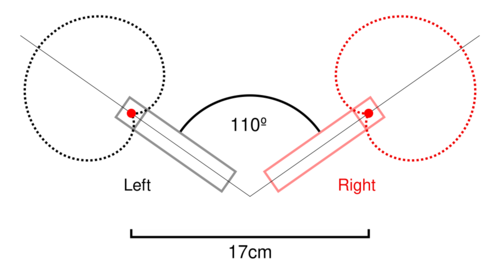
M-S: (intensity-based)
The M/S technique employs a mid (omnidirectional?, sometimes cardioid-directional? to front) cartridge that directly picks up the mono sum signal, and a side (figure-of-eight) cartridge that directly picks up the stereo difference signal.
A native MS recording pair uses a pair of omnidirectional microphone (mid, ) and figure-of-eight microphone (side, ).
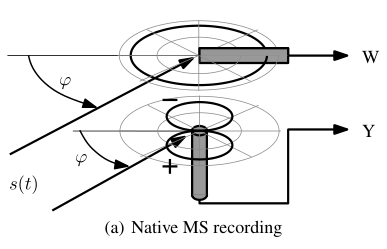
The pickup pattern of this MS microphone pair can be defined as:
where is the angle of the sound source relative to the microphone pair, is the response of the MS microphone pair to sound signals at different angles of incidence , with denoting the mid signal and representing the side signal .
Assuming a signal originates from an angle of , the pickup signals’ gain can be expressed as:
The mid cartridge signal’s relation to the mono sum signal, and the side cartridge signal’s relation to the stereo difference signal, can be expressed as follows:
In other words, the left and right stereo signals are derived from the sum and difference of the mid and side signals
Other Internet Resources
- “Michael Gerzon Audio Pioneer.” Accessed: Apr. 01, 2025. [Online]. Available: https://www.michaelgerzonphotos.org.uk/
- “Sound Effects and Software by Tonsturm - SCHOEPS DoubleMS,” Tonsturm. Accessed: Apr. 01, 2025. [Online]. Available: https://tonsturm.com/product/schoeps-double-ms
References
[1] F. Zotter and M. Frank, Ambisonics: A Practical 3D Audio Theory for Recording, Studio Production, Sound Reinforcement, and Virtual Reality, vol. 19. in Springer Topics in Signal Processing, vol. 19. Cham: Springer International Publishing, 2019. doi: 10.1007/978-3-030-17207-7.d
[2] G. Ballou, Electroacoustic Devices: Microphones and Loudspeakers, 1st ed. Routledge, 2012. doi: 10.4324/9780240812687.
[3] J. Kadis, The Science of Sound Recording, 1st ed. Routledge, 2012. doi: 10.4324/9780240823645.
-
This entry mainly developed its content by re-structuring Zotter & Frank comprehensive Springer handbook of Ambisonics. Also figures come from this book. ↩
-
“Stereo recording techniques and setups.” Accessed: Apr. 01, 2025. [Online]. Available: https://www.dpamicrophones.com/mic-university/audio-production/stereo-recording-techniques-and-setups/ ↩